The Cru
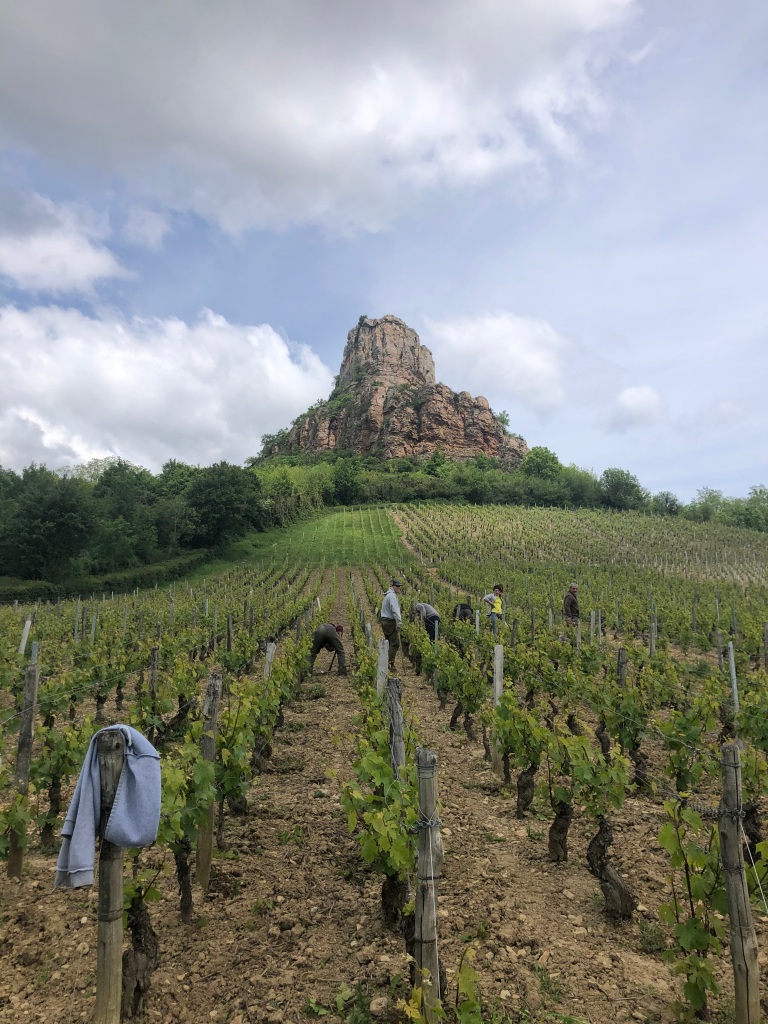
I am standing in Pouilly. A kilometre or so back round to my right is Fuissé. The combination of those names is likely to cause wine buffs to quiver.
I am also standing at the foot of La Roche de Solutré, a dramatic limestone crag. It is unusual in the gently rolling hills of Burgundy but not completely isolated. There is another crag, La Roche de Vergisson, a few kms to the north albeit with fewer features and less definition. This roche however, has interesting archeology, historical horses, a host of birdlife and a museum. It also has a very generously sloping track up which you can stroll for the wonderful views from the summit.
We are here because our friend Andre has wanted to trace the steps of Francois Mitterand’s annual pilgrimage to its summit. I think he said, ‘To see if I can pick up his vibrations.’ It’s the sort of thing Andre would say. (Click below to enlarge the photos.)
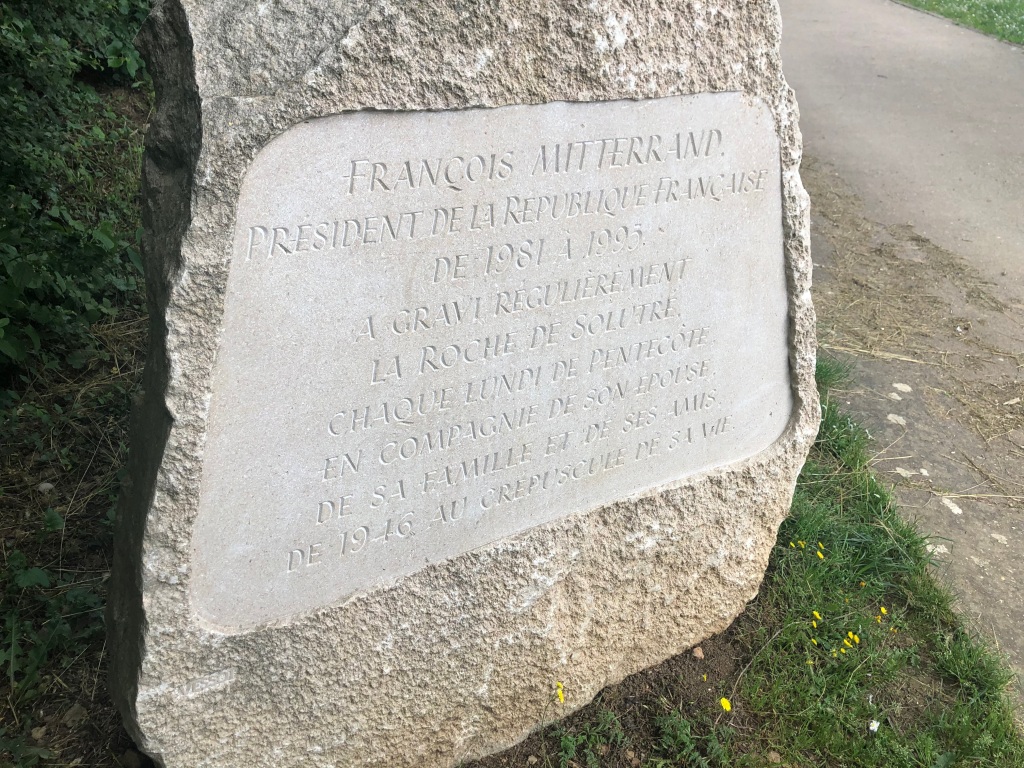
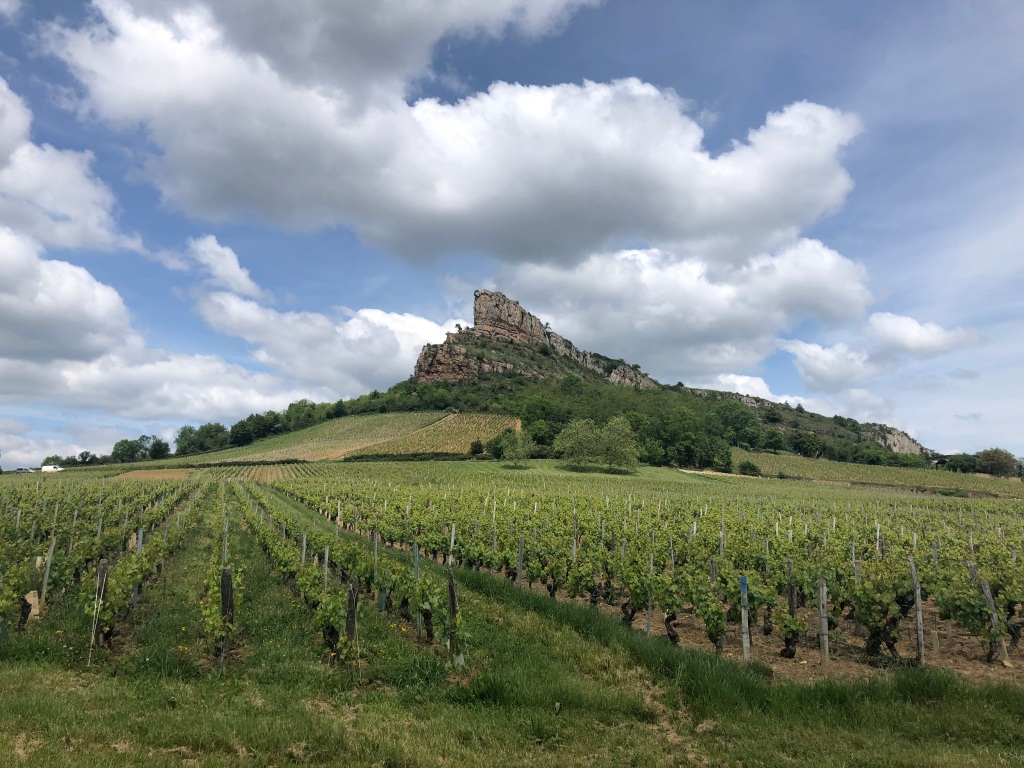
Andre is not the only one who knows about this. The text sculpted into the block says: ‘Francois Mitterand, President of the Republic of France from 1981 to 1995 regularly climbed La Roche de Solutré on Holy Thursday (or ‘Ascension Day’!) in the company of his wife, his family and his friends from 1946 until the twilight of his life.’ Video records suggest that these weren’t solitary meditative events but rather that his ‘family’ and ‘friends’ amounted to a substantial crowd, not to mention the scores of people with cameras, notebooks and sound recording booms.
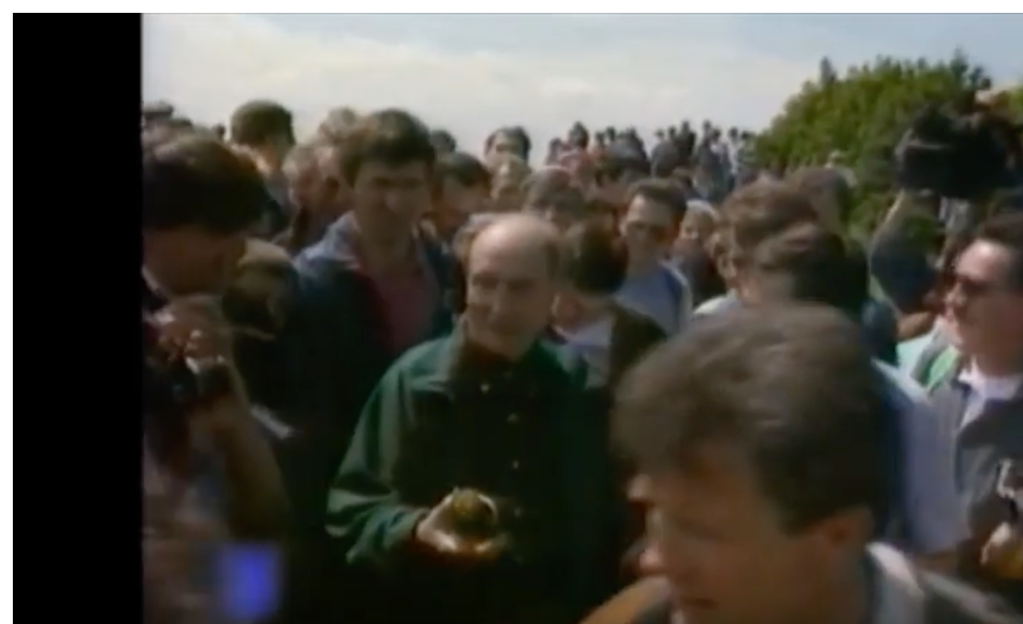
In the first photo I am also looking at a grand cru vineyard. (Grand cru, ‘great growth’.) We are moving here into the region of heritage, sentiment and poetry. Burgundy has climats, but you don’t look up or check the forecast; you look down and rub what’s on the ground between your fingers. ‘Plot’ is a closer translation than ‘climate’. (In passing, Burgundy grows pinot noir and chardonnay with a small amount of gamay and very little else.)
But the source of the grand cru idea is straightforwardly commercial: how do you establish the price of a kilo of wine grapes? And, I believe, it only goes back to 1919 when it was introduced in Champagne as a way of managing issues of provenance and regionality and controlling the influence of middle men who were shaking down growers with no agreed basis for negotiating price.
The vines of each village or smaller defined areas (climats in Burgundy) were given a score ranging from 100% of the annually established ‘full price’ (also ‘grand cru’) down to 22.55%, nameless and rare. It wasn’t long before the vast majority of the Champagne harvest was assessed as being above 80%, although to be in the 90-99% range, premier cru, was still rare and 100%, grand cru, only ever a tiny proportion of harvest. Formally at least, this all came apart under EU rulings in 1990 that centrally indicative prices were incompatible with a free and fair market. (Surely grounds to prompt a Frexit? Surely.)
Generalisations are difficult as each wine region established its own differing criteria and procedure for establishing levels of cru. There was, however, a detailed list of the criteria used historically to define the various crus of Burgundy in the wine museum at Beaune (‘scientific’ in the classic French mode), and I am trying to remember what was on it. Pente was number one. I do remember that, ‘slope’, and I think 5-8 degrees from horizontal was required for grand. ‘Minerality’, ‘aspect’ and ‘drainage’ were three others. So it’s not the grapes; it’s the terroir. Primarily. I think grand and premier cru growers may have been required to have their own chateau and cellars in Bordeaux. Only a tiny number of climats in the long limestone crest of Burgundy where wine is grown were ever designated grand cru.
It might be what the French have instead of superstition.
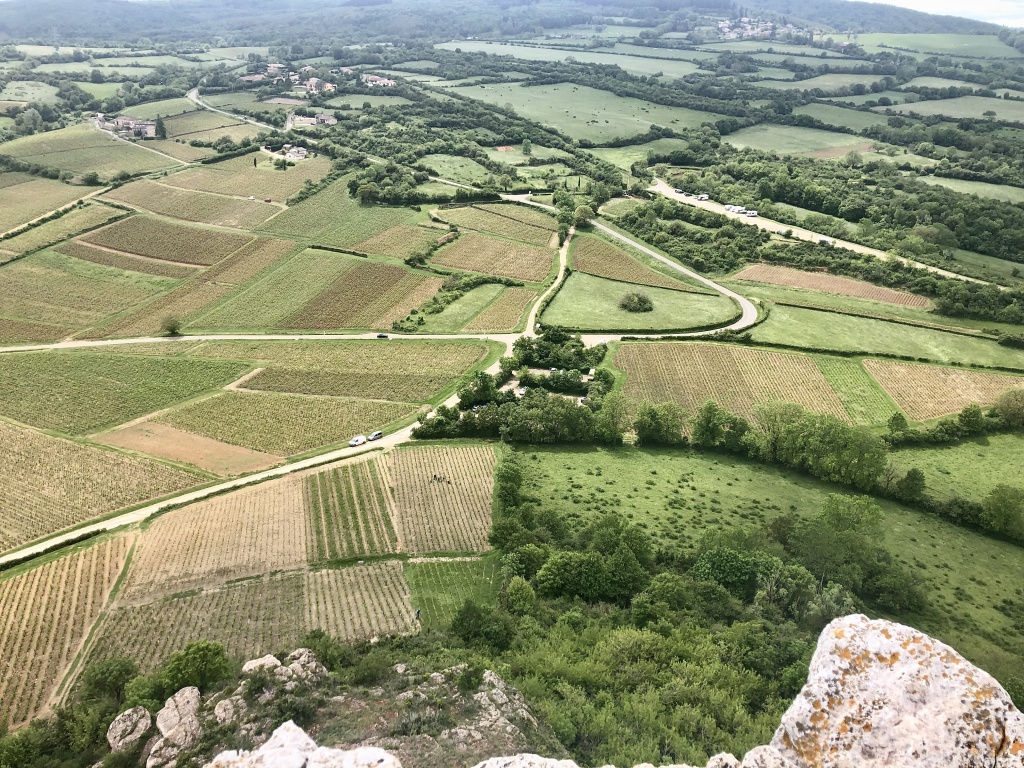
In the first photo I am also looking at a crew tending the vines, still hard at it in the photo immediately above as I notice now. We saw hundreds of these gangs as we drove through the north-south extent of Burgundy. It’s May. Only May I am inclined to say. Harvest will not occur until some time late September/ early October. The muscular knotty trunks of the vines have been pruned over decades and longer to 40-50 cms; the first trailing runner is at present about 60-80cms long. Others are emerging, but only one will be cosseted. And these vines are cosseted. Like pets.
No single person or company will own the entirety of those plots. They will own six rows here and three rows there, another 14 in a plot elsewhere. The elderly maps in the museum recognising this fact contained a maze of information necessarily at a very large scale. We watched a film that suggested that, in some cases, each single vine will be known by their owner and expectations established accordingly. The vendage, the harvest, is a national event. It can be ruined by rain or variations in humidity. The phase of the moon will play its part. As I suggested, wine might be what the French have instead of superstition.
We drank three fancy bottles of wine. The Pommard 2014 at ‘L’Ardoise’ was from what has been a premier cru domaine immediately to the south of Beaune where we were staying. Had something interesting to say at every point and was deeply satisfying. The chardonnay from Meursault (Domaine Michelot, 2018) the next night was like a universe in a bottle. Just so much going on. This is one reason why people like wine: it can be such an organic stimulating almost living thing. In Strasbourg to celebrate our 50th wedding anniversary we had the most expensive, a cab sav from Bordeaux because Andre thinks they’re the best. It started with a bit of promise and at the end left a light mineral note. But in the middle was a gaping void.
One Meal
We weren’t engaged in a visite gastronomique, but with Andre and Robin for company — Andre to dream, describe, categorise, evaluate and generally go on about, and Robin to make it happen — you are likely to eat well. We had two excellent meals in Beaune at L’Ardoise, ‘The Slate’. We were there on the weekend of a public holiday, so joining the throng really. Several dozen restaurants with the cream of the alternatives booked out. Beaune and its vineyards — and its eateries — would always be a popular destination for domestic travel in France. Later we had a very good meal at a golf club near Hagenthal Le Bas. In fact we went up a hill to get there so it might have been Hagenthal Le Haut. Hmm, now I look it was in reality the Basel Golf and Country Club. No wonder it was so posh. It had the advantage of a wonderful view. As did the Krafft Restaurant on the banks of the Swiss side of the Rhine in Basel next day.

And here we are on the bridge over the Rhine on our way there, squinting into the sun coming from the French side and looking just slightly malevolent. Hungry. That’s my excuse.
There were also some very good meals on the walk. But I think the one I most enjoyed was one of the simplest.
We were staying in Beaune in the top floor and mezzanine of a very old building the ‘Chancellors Garden’ which provided access to a small but pleasant deck.
Michael had found a good bottle of pinot and some baguettes. Andre had scoured the super market for superior cheese and cold meats bringing home a wide selection of both. We had bought some fruit and cakes. And we sat in the sun and ate, drank and talked.
The food and drink were extra good but it was the talk that made it memorable. A serious and knowledgeable account of why the Parliament of Europe was an important body; the ways in which democracy could be under threat; the early attempts at town planning in Paris, Grenoble and Melbourne and what that meant for community action, and bureaucracy, at that time; whether or not the set of values that we grew up with were still pertinent or even in existence. Serious, well-informed and interesting talk. You don’t get that every day; I don’t offer it that often. It was just one of those moments.
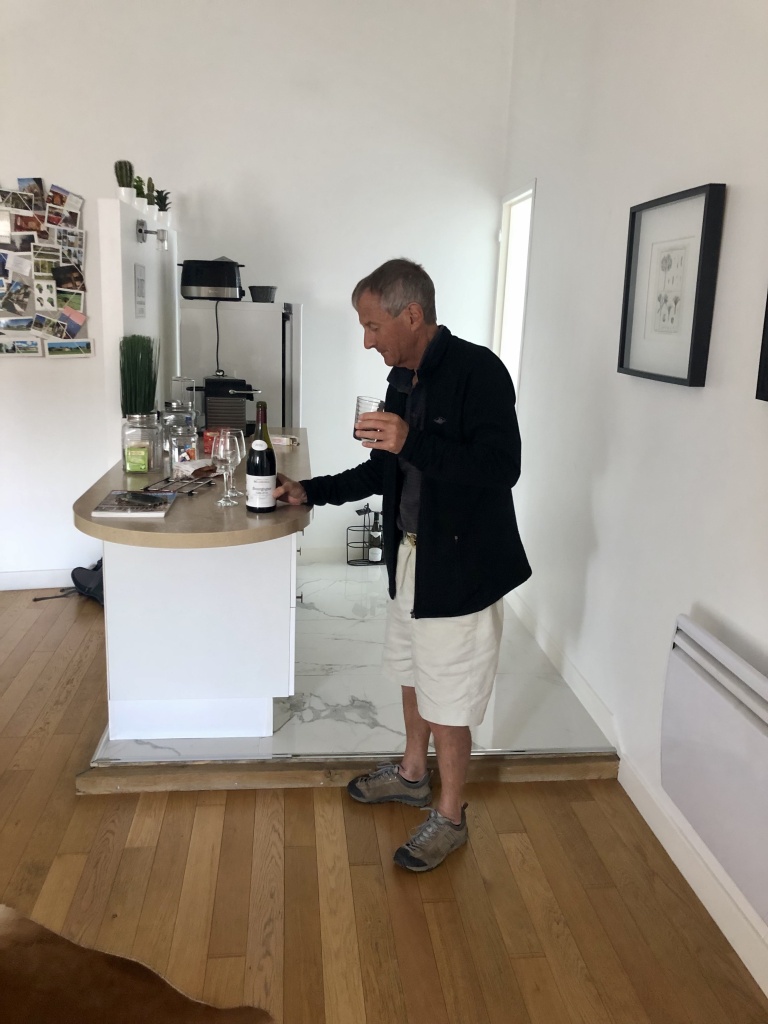
Saint Martha
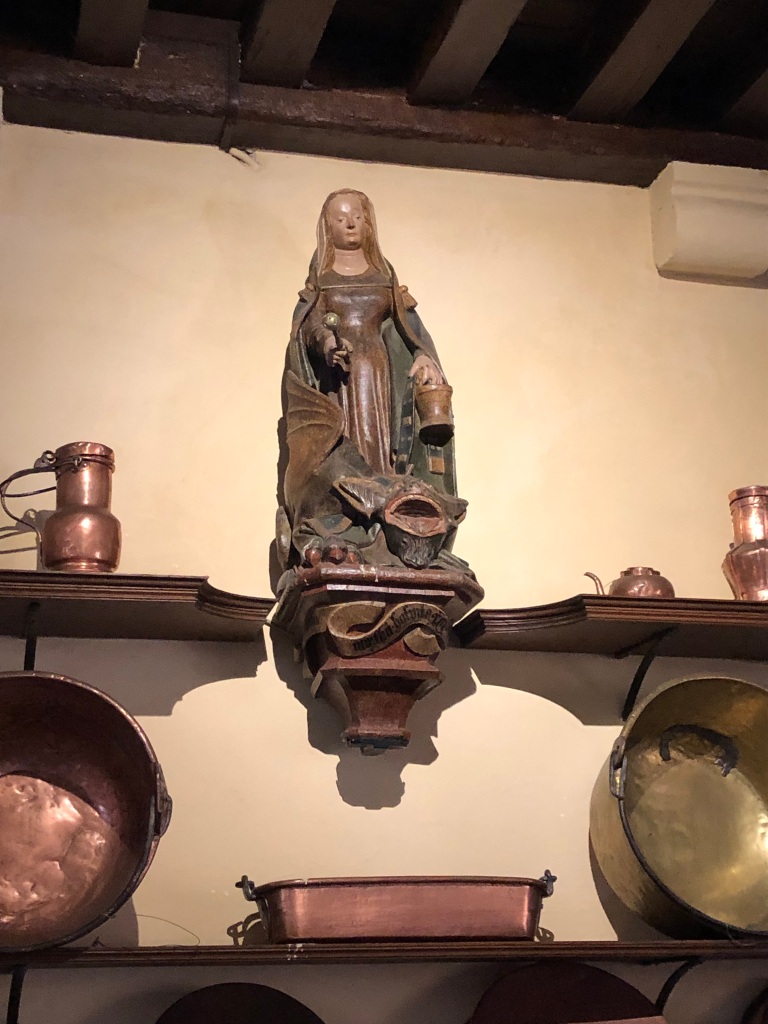
This is a matter of some importance. It is Saint Martha, an exciting discovery at the Hospice of Beaune. The Hospice is a 15th century building realising the fine intentions of the region’s chancellor, Nicolas Rolin, and his wealthy wife Guigone de Salins, to more systematically care for the sick.
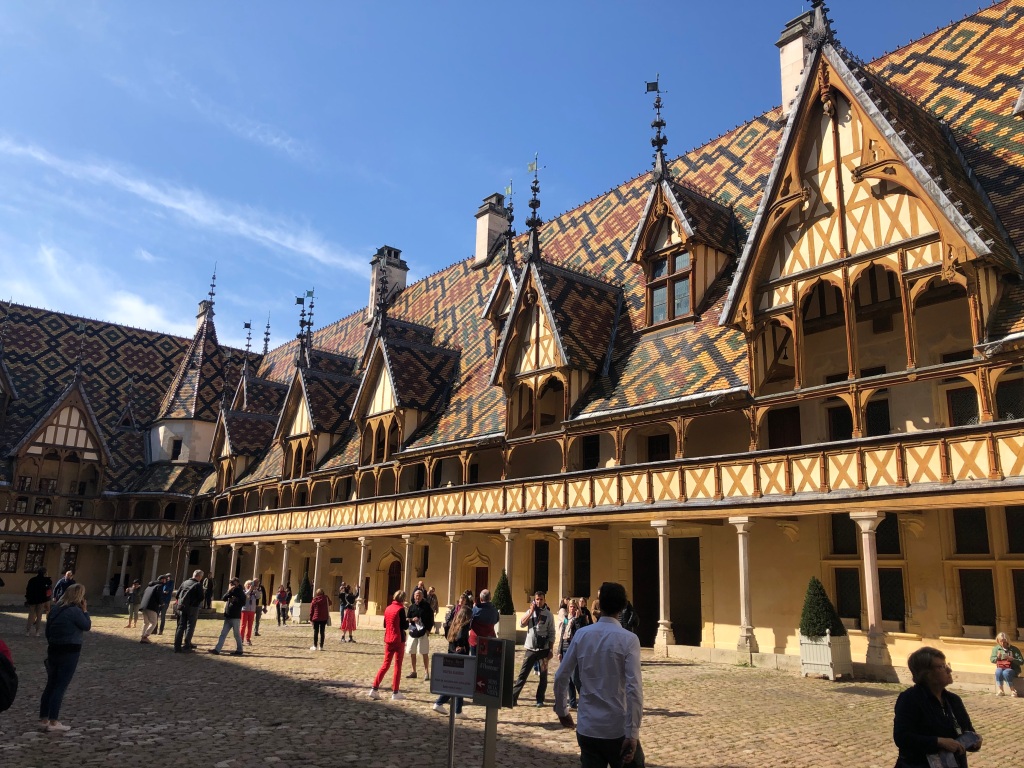
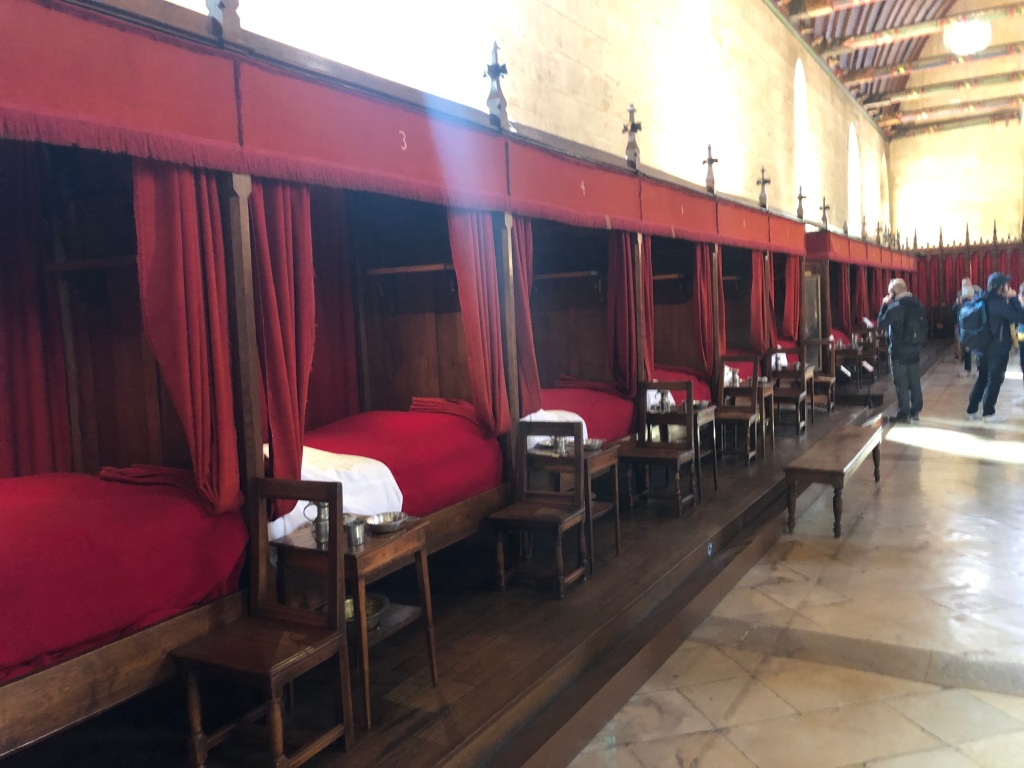
Saint Martha! This is like the bootstudder of a mid-table club winning the Brownlow. There will be those who have known about this situation all along, but I’m not one of them. I’ve always had a soft spot for Martha and not just because of my very positive disposition towards domestic labour. I’ve always thought she got a raw deal.
Luke 10, from verse 38:
Now as they went on their way, [Jesus] entered a certain village where a woman named Martha welcomed him. She had a sister named Mary, who sat at Jesus’s feet and listened to what he was saying. But Martha was distracted by her many tasks, so she came to him and asked, “Lord, do you not care that my sister has left me to do all the work by myself? Tell her, then, to help me.” But the Lord answered her, “Martha, Martha, you are worried and distracted by many things, but few things are needed — indeed only one. Mary has chosen the better part, which will not be taken away from her.”
In contemporary life this is always matched in my mind with an event which occurred years ago when we lived in the Grampians. A distinguished academic and his wife and family were staying with us and about 9 o’clock there was a call from the tent outside: ‘Bernie could you come and give me a hand getting the kids to bed please.’ A very sharp rejoinder. ‘Not now Mary. I’m on ideas.’
‘I’m on ideas’ has entered our venacular meaning, ‘I’m such a hopeless self-absorbed prick it’s almost funny’, and I’m afraid I’ve never been able to dismiss the idea that in the Biblical case the Lord may have been on ideas and that Mary was only encouraging him. They could have done the dishes first, and then got on ideas. But I have no evidence that this is a popular idea. I think the general run of thinking as well as the tendency of the story is: Yeah Mary. She’s got her priorities straight. Off to the concert/ ball/ party. We’ll do the vacuuming tomorrow. Or Mum will. And if she goes all long-suffering on you, mention the Lord.
And, lo and behold, in this grand household in Beaune, so emphatically embodying good works, here’s Martha being celebrated. Love that. Pleased. And if she’s rendered as very plain with what could be called a long-suffering expression on her face, what the. Realism is not a new movement in art. It’s a hospice. She’s probably been on the bedpans.
In fact, and this is the basis of her sanctification, in her day she successfully tamed a ‘monstrous beast’, The Tarask (look at the pic more closely), living on the banks of the Rhône (🤔), by sprinkling him with holy water. ‘She then tied her girdle to its neck, leading the beast to the villagers who cast rocks and spears at it until it died.’ Wow. A bit much? OTT? The Tarask: ‘A huge dragon, fatter than a bull, longer than a horse, it had the face and head of a lion, teeth sharp as swords, the mane of a horse, a back that was hatchet-sharp with bristly scales keen as augers, six feet with bear-like claws, the tail of a serpent, and a double shield/carapace — like a tortoise’s — on each side, with poison breath that could kill living creatures.’ And I think that when the holy water came out there was a person hanging out of its mouth, so there is little question that zero-tolerance, even fatal, intervention was warranted. Fair play all round.
I’m reading this as the capacity of the calm and fully-grounded to take the sting out of the exotic and near frivolous. Saint Martha was adopted by the nursing sisters of the hospice as their protectress, and is the patron saint of servants. (Servants! … oh gosh, that’s a bit of a blow. Not really the idea. Ah well. Not On Ideas I guess …).
Le Corbusier’s wimple
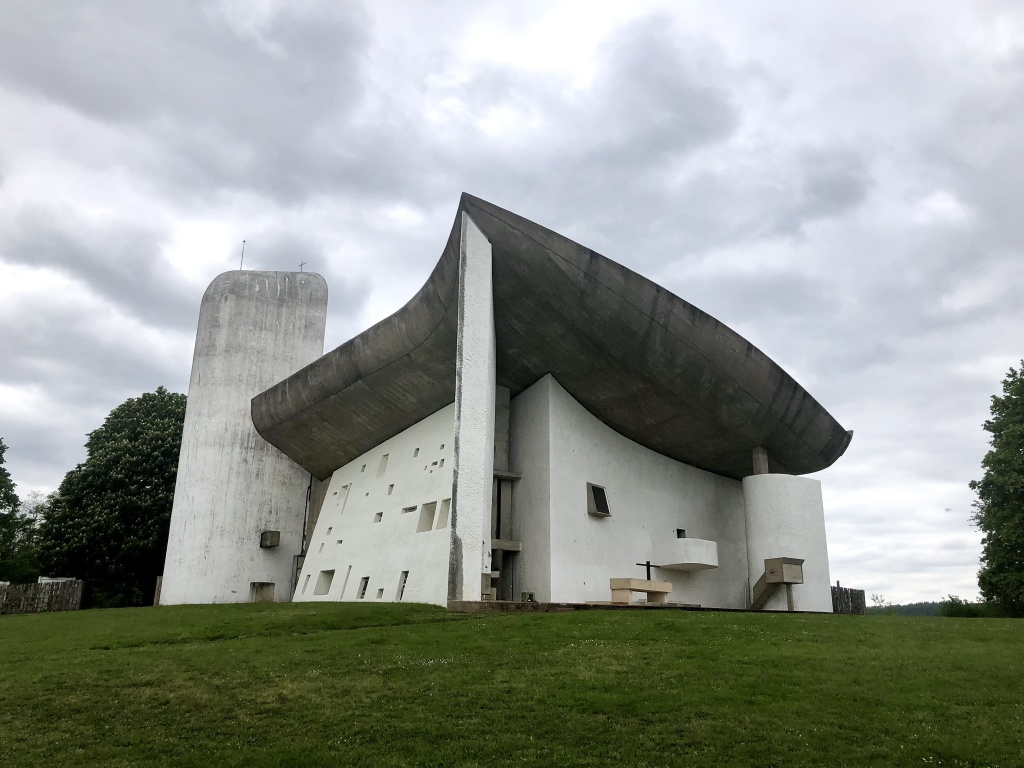
We decided to visit two places on the drive between Beaune and Basel. The first was the Château du Clos de Vougeot which was a bit of a fizzer. The second was Notre-Dame du Haut just out of Ronchamp.
As its name suggests it is a Catholic chapel sited on a very pretty hill with 360 degree views, towards the Jura to the south and east, the Vosges to the north.
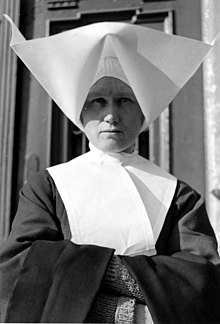
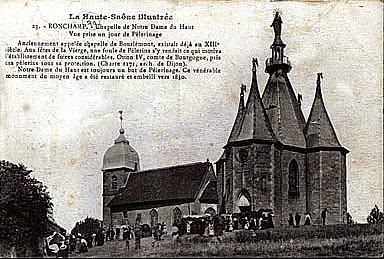
The original building, at left, some of it dating from the 4thC, was destroyed in 1943 by German bombing. After the war, it was decided to rebuild on the same site. Le Corbusier (a nickname, no first name), one of the most prominent architects of the 20thC, was commissioned to design a new one.
The new chapel ‘was built for a reformist Church looking to continue its relevance’. Planning began in 1952 and the building was finished in 1955. The result was controversial from the first. The chapel is small and eccentric. The materials are not conventional. The pic above is taken from the photogenic angle. ‘Round the back’ was covered in scaffolding when we were there, but with the scaffolding down it still looks a bit like a utility area with a staircase somewhat inelegantly running through it. And yet, in 2016 it was placed on the UNESCO World Heritage List because of its importance to the development of modernist architecture.
The ‘tower’ is in Burgundy stone. Most of the rest of the structure including the roof is reinforced concrete. The walls’ surface has been sprayed with shotcrete which is just what it sounds like, pneumatically-sprayed concrete giving a very heavily textured finish, and then painted white. The roof is not sitting on the walls. It is sitting on pylons built into the walls allowing a clerestory, visible below, of perhaps 150mm to let light in and perhaps to provide the illusion that it is floating.
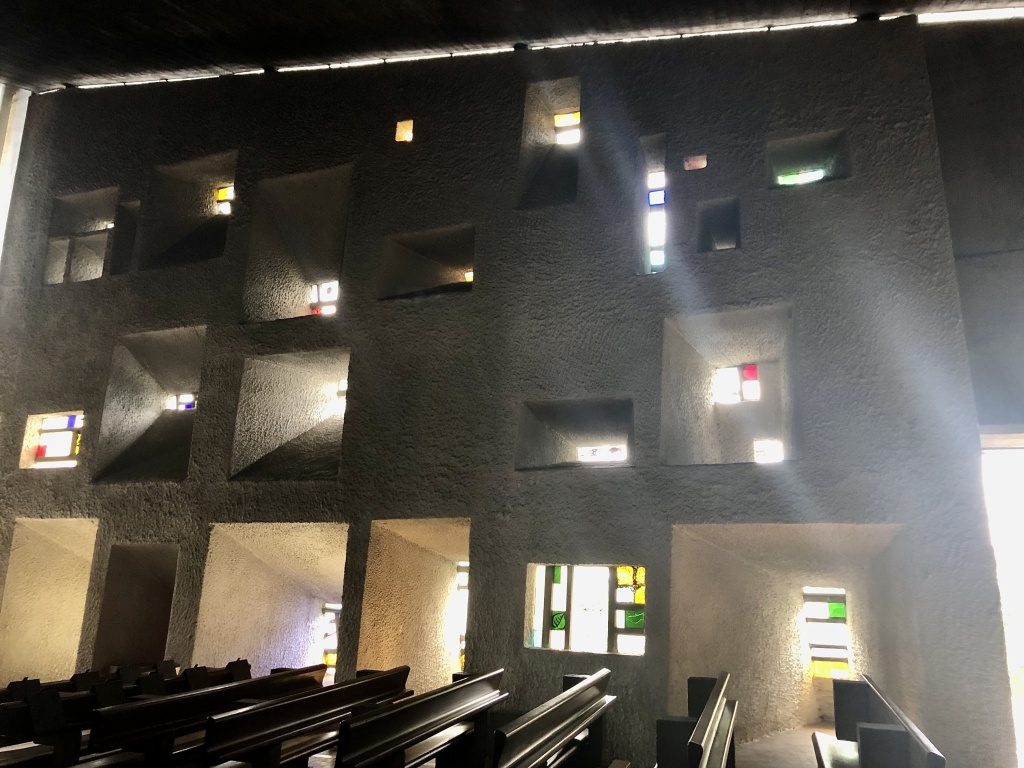
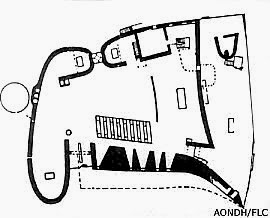
Above is the south wall from the interior. At left is a plan which indicates the unusual character of that wall. It begins from a point (at right) and eventually becomes more than 3 metres thick. Not customary practice. As a result the ‘windows’ are not just irregularly placed with irregular colours and patterns, but are of irregular depth. At bottom right in the photo you can see that the window indentation has almost become a small room.
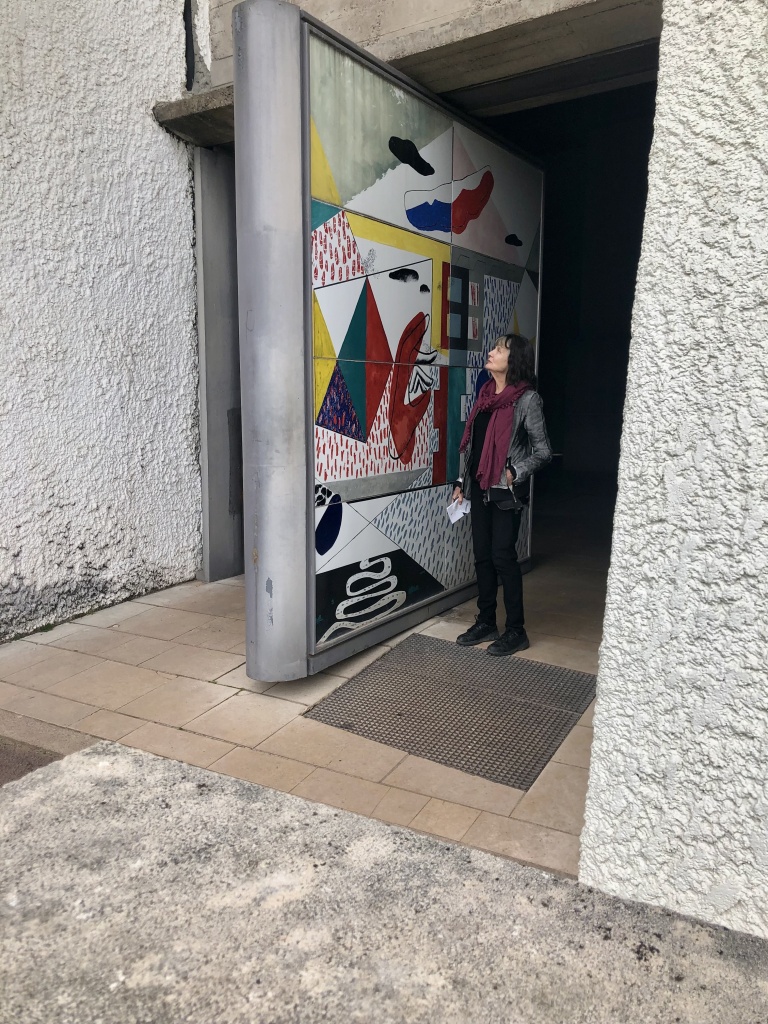
So far, so good.
I think I was alone among the five of us in liking the interior. I found it meditative and probably conducive to worship. (It has a very small regular congregation, a handful, although there is a ‘working’ convent adjacent down the slope.) It’s the exterior where the problems emerge. You could say it looks just a little bit 1955, modernity unleashed but unresolved, and that suggests the main problem — reach exceeding grasp. Today you could build this much more easily than you could in 1955. It would look less ragged and ‘home-made’ (maybe undesirably), and would be far more durable.
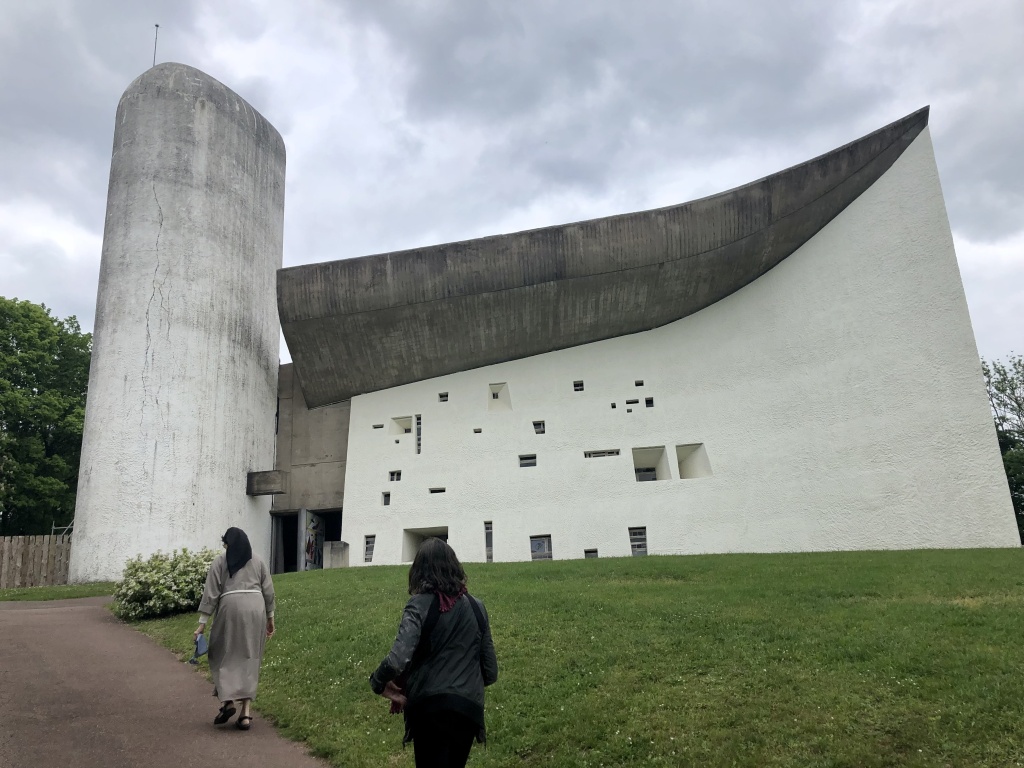
Recently €4m has been spent renovating the south wall which looks good but, as you can just see in the photo, is still standing off the tower. A black filler has been used to seal the gap which probably means problems with the foundations managing the extraordinary weight and eccentric loading that south wall imposes.
The roof is reinforced concrete too, a wildly ambitious stroke. It gives you the wimple, but it must have been shockingly difficult to build. And it shows. The right hand corner that we can see has extensive concrete sickness with rusty steel reinforcement exposed. (In the first pic above, it can be seen in the ‘point’ of the south wall, roof to ground.) Not the complete kiss of death but very difficult and very expensive to fix. It may need in the order of another €8-10m to sort out the whole building.
Various arms of government, and the public, have been generous to date. But would you? Would you keep at it? The only basis for doing so is to consider the chapel as what it is, an artefact, a cultural phenomenon (oddity?), rather than a working building. And even then … How many worms in that can?
I was very pleased to have seen it, but we didn’t, as invited, leave a donation.
The new Kunstmuseum (art gallery) in Basel
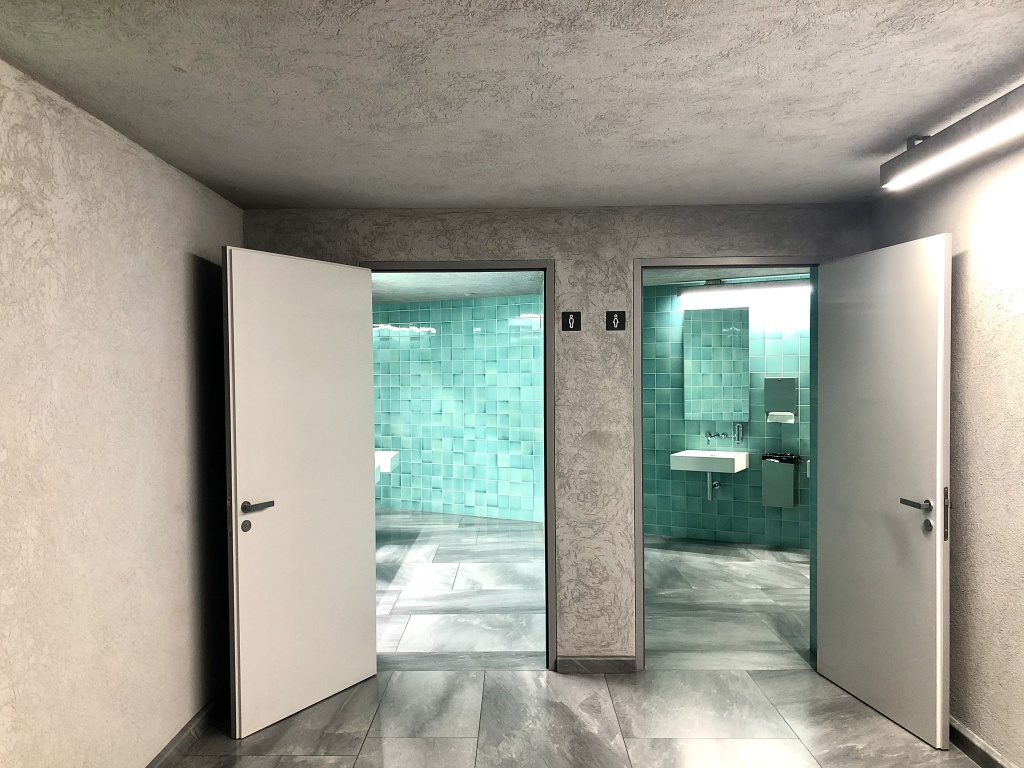
Now that’s design. Less ambitious, but ever so stylish. (Below the lads enjoying the gallery experience.)
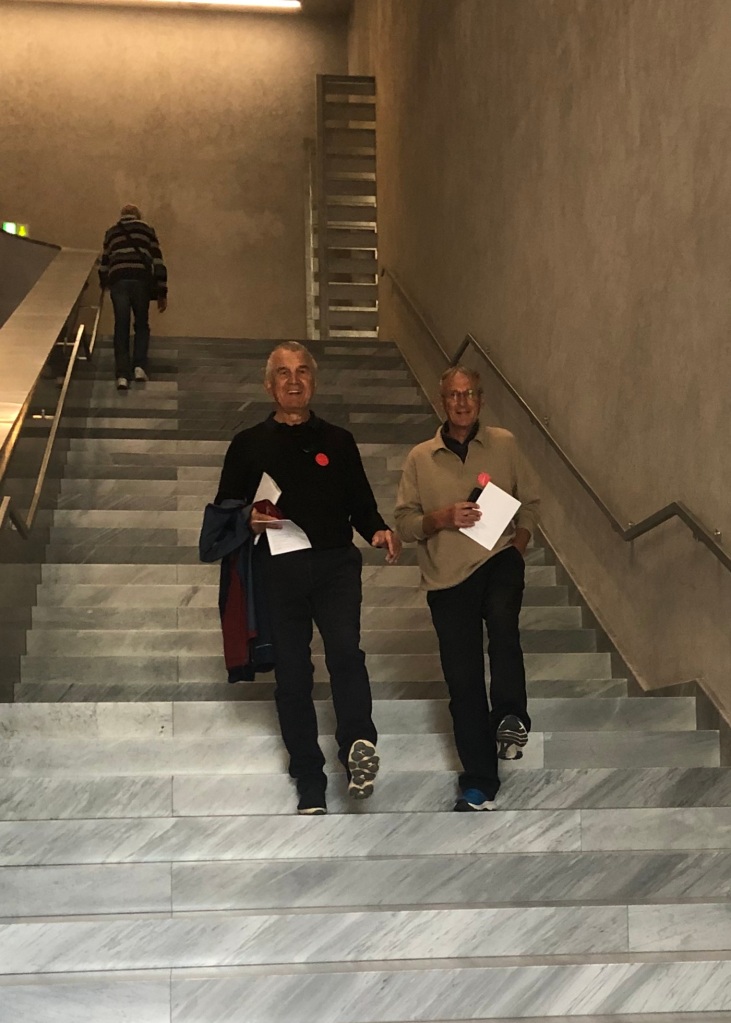
• • • • • • •
OKAY. Ça suffit! Enfin, Singapore and money. Close friends.

You suggest that France may have wine instead of superstition but they certainly have both. Catholicism rules in France and is the height of superstition.
you have memorialised it beautifully in words and photos, and done all the work. i had had a phantasy of wine tasting from oak barrels, and andre sent me a photo of lots of old oak barrels, but we were presented with modern wine containers and no wine tastings on site.
Still what we did get to taste was delicious, But i think the wine varies with the company and event. and we got lucky. The french ask for a metre or two of vines and the greeks a few olive tress. seems reasonable.